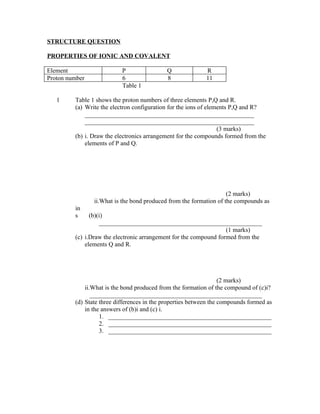
Structure & essay Questions (chemical bond)
- 1. STRUCTURE QUESTION PROPERTIES OF IONIC AND COVALENT Element P Q R Proton number 6 8 11 Table 1 1 Table 1 shows the proton numbers of three elements P,Q and R. (a) Write the electron configuration for the ions of elements P,Q and R? ______________________________________________________ ______________________________________________________ (3 marks) (b) i. Draw the electronics arrangement for the compounds formed from the elements of P and Q. (2 marks) ii.What is the bond produced from the formation of the compounds as in s (b)(i) ____________________________________________________ (1 marks) (c) i.Draw the electronic arrangement for the compound formed from the elements Q and R. (2 marks) ii.What is the bond produced from the formation of the compound of (c)i? _______________________________________________________ (d) State three differences in the properties between the compounds formed as in the answers of (b)i and (c) i. 1. ____________________________________________________ 2. ____________________________________________________ 3. ____________________________________________________
- 2. JAWAPAN 1 (a) Element P : 2.8 Element Q : 2.8 Element R : 2.8 (b) i. ii. Covalent bond (c) i. ii. Ionic bond (d) Compound PQ2 Compound R2Q Melting & boiling point Low High Votality High Low Conductivity of electricity Does not conduct Can conduct in the molten state
- 3. ESSAY QUESTION 1 Elements Group Period W 1 3 Y 14 2 Z 17 3 Table 2 (a) With the help of an electron arrangement diagram, explain how two elements from Table 2 can combine to form (i) An ionic compound and (ii) A covalent compound (14 marks) (b) State the differences between an ionic compound and a covalent compound. (6 marks) JAWAPAN 1 (a) (i) - Two elements that form an ionic compound are W and Z. 2 - Electronic configuration of atom W is 2.8.1 and electronic configuration of atom Z is 2.8.7 2 - To achieve the stable octet in the electron configuration of a noble gas. 1 - An atom W release one electron to form a W+ ion. 1 - An atom Z accepts one electron to form a Z- ion. 1 - The positive ions and negative ions formed are attracted by the strong electrostatic force of attraction. 1 (ii) - Two elements that form covalent compounds are Y and Z 2 - Electronic configuration of atom Y is 2.4 and Z is 2.8.7 2 - One atom Y contributes four electrons to be shared with four atoms of Z. 1 - Four pair of shared electrons
- 4. form four single covalent bonds 1 (b) Three differences between an ionic compound and covalent compound - An ionic compound has high boiling and melting point whereas a covalent compound has low melting and boiling point. 2 - An ionic compound is soluble in water but is insoluble in organic solvents, whereas a covalent compound is soluble in organic solvents but is insoluble in water. 2 - An ionic compound conducts electricity in the liquid state and in aqueous solution whereas a covalent compound does not conduct electricity in any state. 2
